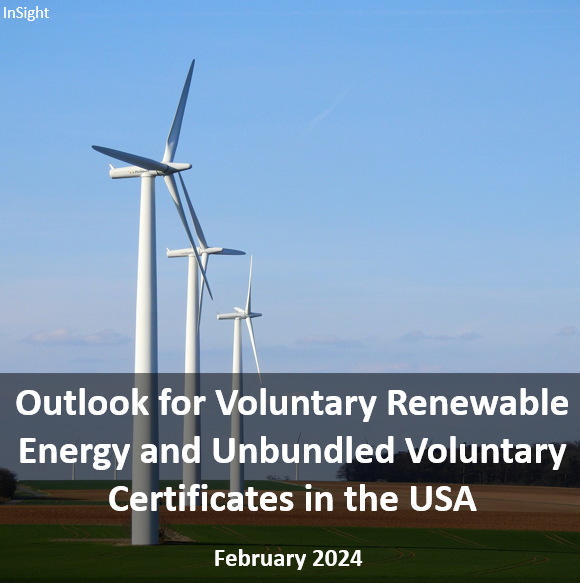- Home
- Markets
- Cap & Trade
- Clean Fuels Standard
- Carbon Offsets
- Carbon Linked Mechanisms
- Get to Know
- Market Coverage
- Cap & Trade
- Clean Fuels Standard
- Carbon Offsets
- Carbon Linked Mechanisms
- Use Cases
- About us
- Membership Plans
- InSights
- Webinars
- Scenario Simulators
- CAFÉ
- CAFÉ – Carbon Analysis Forecasting Engine Enter my CAFÉ
- Cap-and-Trade
- Clean Fuel Standards
- Carbon Offsets
- InSights
- Outlook for Voluntary Renewable Energy and Unbundled Voluntary Certificates in the USA | Insight Report | February 2024
 Cap-and-TradeCFS Cross-MarketCaT Cross-MarketI-RECsNA RECsUK ETSVCMOR CFPBC LCFSCA LCFSEU ETSWCI CCOs & WCOsRGGIWashington CaIWCI CaTOther CaT NewsAlberta TIEROutlook for Voluntary Renewable Energy and Unbundled Voluntary Certificates in the USA | Insight Report | February 2024
Cap-and-TradeCFS Cross-MarketCaT Cross-MarketI-RECsNA RECsUK ETSVCMOR CFPBC LCFSCA LCFSEU ETSWCI CCOs & WCOsRGGIWashington CaIWCI CaTOther CaT NewsAlberta TIEROutlook for Voluntary Renewable Energy and Unbundled Voluntary Certificates in the USA | Insight Report | February 2024Monday, 12th February 2024
An unprecedented report providing the first comprehensive forecast focused on the Voluntary Renewable Energy Certificates (VRECs) market in the United States.
The report represents a significant milestone in the understanding of VRECs dynamics, offering insights into the market’s evolution and future trajectory. With meticulous analysis and robust forecasting methodologies, cCarbon’s report aims to provide stakeholders with invaluable strategic guidance.
Key Highlights of the Report:
- Critical Decade Ahead: The next 10 years emerge as the most pivotal period for the VRECs market, shaping the trajectory of the clean power transition in the United States. During this period, strategic decisions and policy actions will profoundly influence the market’s evolution and impact.
- Transition to Clean Power: As the clean power transition accelerates, the report emphasizes that the next decade will witness a paradigm shift where clean power becomes the norm. Consequently, the value of the clean power attribute, including VRECs, is expected to undergo transformation, potentially diminishing its significance in the long term.
- Strategic Imperatives: Stakeholders are urged to leverage the insights provided in the report to navigate the evolving landscape of the VRECs market effectively. With the market poised for transformative change, proactive engagement and strategic planning are essential to capitalize on emerging opportunities and mitigate risks.
Table of Contents
1. Executive Summary
1.1 The Rise of VRECs
1.2 Comparing Voluntary Markets of VCM, Voluntary Renewable and Unbundled VREC Supply
1.3 Supply of Voluntary Renewable and unbundled VRECs
1.3.1 Texas is the largest source of Voluntary RECs in the US
1.3.2 The North American Renewables (NAR) Registry another important Voluntary RECs registry
1.3.3 Red states dominate supply of Voluntary RECs
1.4 Demand for VRECs
1.4.1 Retail and Technology Sectors have been buying Texas RECs
1.5 Manufacturers apparently lead the way for NAR retirements followed by food retailers and technology companies. (Based on a 5% sample disclosed by NAR)
1.6 Prices of VRECs
1.7 Conclusion
2. Introduction to RECs
2.1 Purpose of RECs
2.2 Our terminology for the difference in RECs
2.3 What’s the difference between Compliance and Voluntary RECs?
2.4 Bundled and Unbundled RECs
3. Context for the growth of Voluntary RECs in USA
3.1 Overview
3.2 Voluntary RECs an important source of decarbonizing Corporate Scope 2 emissions
3.3 Corporates have multiple pathways of decarbonizing Scope-2 emissions
3.4 Data shows Unbundled VRECs and PPAs are the by far the most popular tools to use green power
3.5 Growth of the VREC Market
3.6 How are RECs tracked – The Mosaic of REC registries in North America
3.7 Sizing the US VREC Market
3.7.1 Value of the US VREC Market
3.7.2 Comparing VREC Market and Voluntary Market
3.7.3 Value of VRECs and VCM Supply
4. Regional Analysis
4.1 Regional summary: A tapestry of systems
4.2 The divide between red and blue states
4.2.1 Voluntary renewable credits supply is dominated by Red states
4.2.2 Red states driving the expansion
4.2.3 Significant increases in credit issuance from Democratic states, but not on same scale as Republicans
4.3 Texas, ERCOT: The largest source of VRECs
4.3.1 ERCOT has seen growth in 3 phases
4.3.2 Voluntary REC retirements reached over 100 million in 2022 in Texas.
4.3.3 Retail and Technology Sectors are the big recent buyers of Texas RECs
4.4 North American Registry (NAR)
4.4.1 NAR’s role as a voluntary trading hub for State Registries.
4.4.2 NAR’s Imported capacity
4.4.3 NAR represents the second largest source of voluntary RECs in the US
4.4.4 A sample of 5% of NAR retirements shows that manufacturers lead the way followed by food retailers and technology companies.
4.5 Other registries
4.5.1 MRETS
4.5.2 Michigan Renewable Energy Certification System (MIRECS)
4.5.3 North Carolina Renewable Energy Tracking System (NC-RETS)
5. Supply Outlook for Voluntary RECs – Strong growth in the coming decade
5.1 Our Modelling approach balances green power production and compliance requirements
5.1.1 Factors affecting VRECs supply
5.2 The USA Outlook of VREC Supply: Putting the Pieces together.
5.2.1 Modelling Results VREC Supply Scenarios: Voluntary RECs
5.2.2 Modelling Results VREC Supply Scenarios: Unbundled Voluntary RECs
5.2.3 A more detailed Comparison of Scenarios
5.2.4 Summary of Supply Scenario
6. Demand outlook for Voluntary RECs
6.1 Key Stakeholders of VREC Demand
6.1.1 Scope 2 emissions continue to decline due to uptake of renewable energy
6.1.2 Texas has the highest commercial and industrial Scope 2 emissions – significantly higher than California.
6.2 Program initiatives: RE100, SBTi, and others
6.2.1 RE100 fueling the demand of Voluntary RECs across the USA
6.2.2 USA has the most RE100 companies, including a wide variety of sectors.
6.2.3 Many US corporates are moving faster than their 2050 net-zero goal
6.3 Corporate profile of VRECs based on Registry Data
6.3.1 ERCOT Company profiling of VRECs
6.3.2 NAR Corporate profiling of VREC Demand
6.3.3 Corporate Profile in the ERCOT and NAR Registries – and their Scope 2 emissions
6.4 The expected demand decline for V-RECs post 2030
7. Pricing Outlook of Compliance and Voluntary REC
7.1 Voluntary REC Price Outlook
7.2 Analysis of RECs’ open interest and traded volumes – ERCOT has most volume
7.3 Other Compliance REC Prices
7.3.1 Comparison of Solar REC across USA States
7.3.2 Comparison of Wind REC across USA states
8. Synthesis: possible levers and changes to watch out for
9. Annexure
9.1 Data sources for RECs Registry and types of Data available
9.1.1 Other markets of RECs
9.2 USA Electricity Generation and EIA projections
This report is for members only. Purchase Report
Explore Membership Options to get access to this InSightcCarbon has mapped both the demand as well as supply of SAF to size the market. The research indicates that global SAF consumption in 2022 (as per offtake agreements) stood at 494 million litres.See MembershipsYou might also likeRGGI Market: Forecasting the Landscape | Analyst Note | April 2024 Alberta TIER Market Analyst Note: A new model for North American carbon markets | Analyst Note | April 2024 California LCFS Market Outlook Ahead of New Regulations Coming In | Analyst Note | April 2024 View All Analyst NotesAnalyst Notes
Outlook for Voluntary Renewable Energy and Unbundled Voluntary Certificates in the USA | Insight Report | February 2024 North American Renewable Natural Gas Outlook 2030 | Insight Report | January 2024 North American Renewable Diesel Outlook 2030 | Insight Report | October 2023 View All Insight ForecastInsight Forecast





- No data Found!
Free Trial or Login to access
Our market portals and InSights are only for logged-in users with the relevant access. This can be you too…
Your Current Membership Does not Include this Content
This content is outside of your current package. If you need this too, let’s talk…
Solve Your Problems
Send this problem to our Clients team, and we will get back to you shortly with a plan of attack.
orSpeak and exchange notes with our specific-market expert, use your complimentary hours.
Arrange with Client TeamLet's Connect
Tell us who you are, and what you're after. We'll find you the right person with the answer - before you wake up twice.
Request Access to Data Tool
Tell us who you are, and what you're after. We'll find you the right person with the answer - before you wake up twice.
Newsletter Sign Up
Your name and email in exchange for staying up to date across the world's environmental markets... what a deal?!
MEMBERSHIPS
Sign Up for Free Trial or Login to Access Market Dashboard
Your Current Membership Does not Include this Content
This content is outside of your current package.
If you need this too, let's talk…My Saved Selections
Phasellus tempor tincidunt sem, sed dictum ipsum mollis vitae. Maecenas eu diam convallis, pellentesque lacus et, mollis enim.
ID # Custom Name Created On Insert From My Saved Selections
Phasellus tempor tincidunt sem, sed dictum ipsum mollis vitae. Maecenas eu diam convallis, pellentesque lacus et, mollis enim.
# ID Custom Name Created On My pinned contentThere is no pinned content to display - Clean Fuel Standards
- Clean Fuels Standard
- Cap & Trade
- Clean Fuels Standard
- Cap & Trade

 Webinar
Webinar